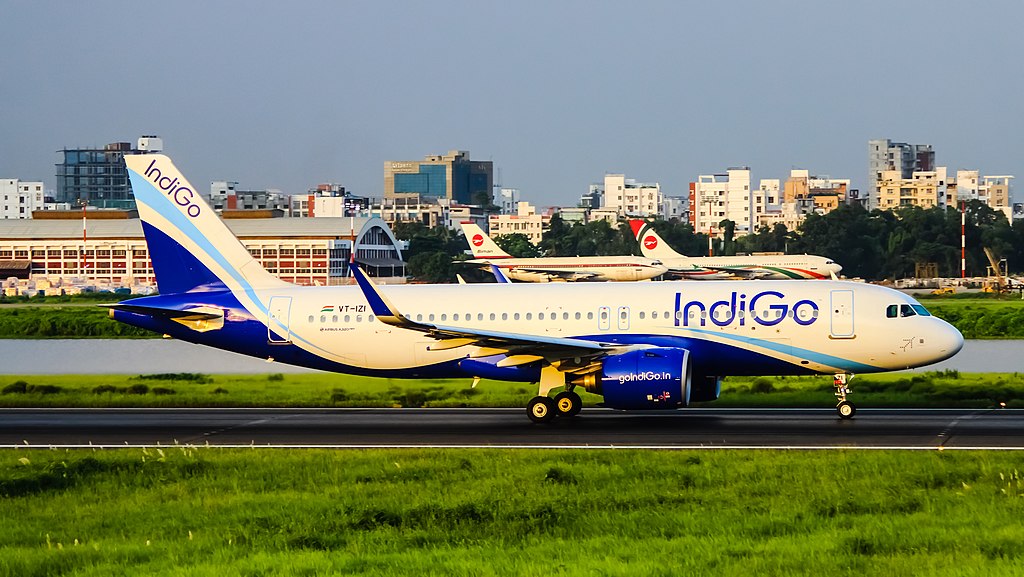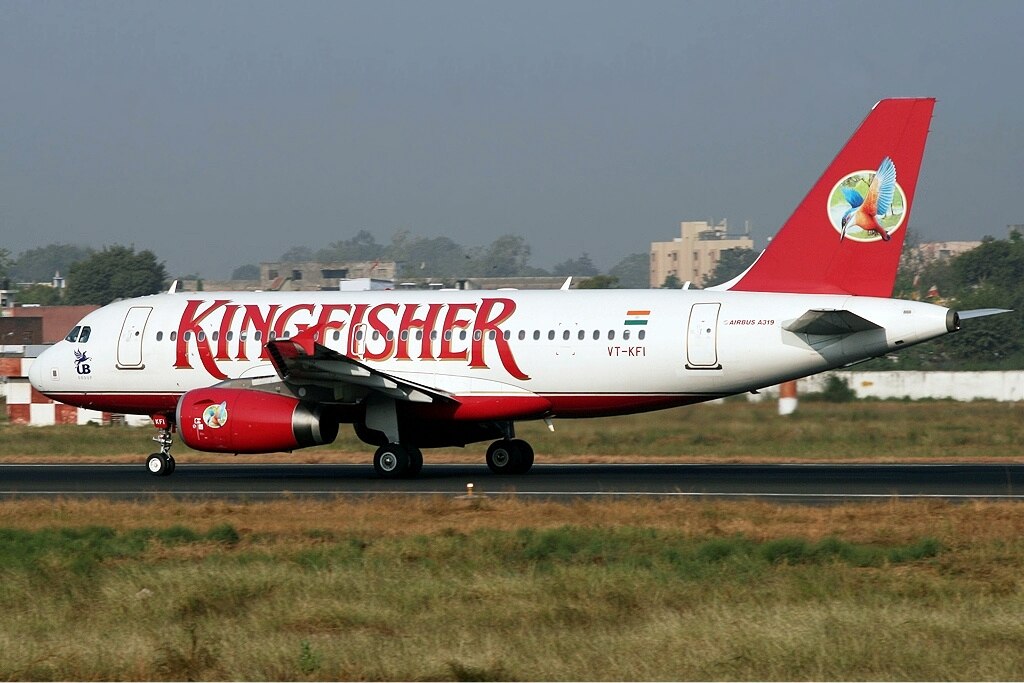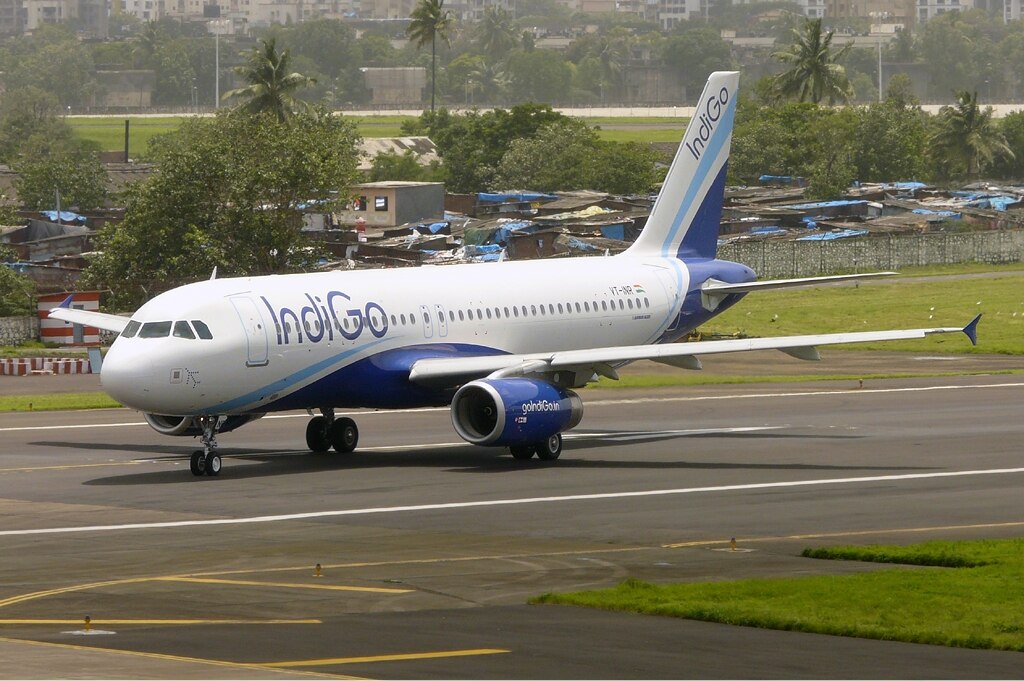
Photo: Md Shaifuzzaman Ayon | Wikimedia Commons
IndiGo revolutionized Indian aviation with relentless efficiency and pocket-friendly fare. So much was the pocket-friendliness of the domestic flight tickets that the carrier allowed fares less expensive than trains (international flights were less than $60). From its humble beginnings in 2006, the carrier has a current market share of a staggering 63% market. Statistics such as the 432 aircraft in its current fleet (168 of them being historic), 2,200+ daily flights, and millions of annual passenger numbers, the airline is among the top hundred airlines in the world.
Airlines from India have a rich history of failure. In a nation where an airline founded by a visionary such as J.R.D Tara was brought down to its knees, Indigo has proved to be different.

IndiGo’s first A320s—the bold bet that launched the airline’s aviation revolution.
Photo: Md Shaifuzzaman Ayon| Wikimedia Commons
The Bold Takeoff: Founding and Early Gambles
In 2005, a startup by Rahul Bhatia (the founder of a Gurgaon-based travel and logistics company caleed InterGlobe Enterprises, ) and Rakesh Gangwal (an aviation veteran who had previously worked with one of the Big Three airlines of the US- United Airlines and US Airways). The two were involved in Caelum Investment in the US which would later hold 47.88% ownership in their joint venture IndiGo. InterGlobe held a 51.12% stake in this airline.
IndiGo, an airline which was perhaps in its first flush, outright placed an order of 100 Airbus A320-200 aircraft. This was much to the surprise of many. India already had players such as Kingfisher, Jet Airways, SpiceJet, among others, who were already established in the aviation space in India. Sceptics wondered if an airline, which had not even began its operations (and therefore was relatively untested in the market), would be able to perform well. However, Airbus, a manufacturer whose aircraft name starts with the letter A and the number 3, believed that the new carrier had “high-quality executives” and was sure to be “a successful new player”, as quoted in the BBC.
IndiGo’s plans were straight. They were to be a budget carrier, meaning that the airline would offer neither frills nor freebies.
2006 marked Indigo’s first flight (Delhi to Imphal). The airline started its operations a month after the delivery of its first aircraft. Within a year, their fleet had scaled to 15 aircraft. They also operated under the sale and leaseback model – . Under this model, an airline acquires aircraft (such as those done by Indigo in their massive order) at an agreeable price. The aircraft is then sold at a profit to a lessor, only for the airline to lease it back for its own use. This strategy was was called the “centerpiece of IndiGo’s massive aircraft orders“:
“In addition to cash-flow considerations, leasing traditionally is also driven by liquid credit markets, low interest rates, high competition and high demand. When these elements align, it makes for an attractive financing environment where airlines are able to have banks, lessors and even manufacturers compete and get extremely good financing offers. Within this, one model that has been successfully leveraged by IndiGo…”
In 2006, more than a million passengers traveled via Indigo. In addition to routes along the four major cities in India- Delhi, Mumbai, Banglore, and Kolkata, the airline also added additional routes.
But turbulence hit in 2008: fuel prices spiked and the Indian rupee flailed, leading to the floundering of airlines such as Kingfisher. IndiGo responded to this period of uncertainty by cutting down unprofitable routes (i.e., only operating flights to and from the four major cities listed above), cutting down routes that weren’t as profitable (and thereby making operations more efficient).
Despite the fact that IndiGo was already using fuel-efficient aircraft (of the A320 family), it also focused on offering “direct routes” [not to be confused with “direct routing”*] to save fuel.
[ *Direct routing involves the skipping of certain “waypoints” that are a part of the flight plan of the aircraft. This saves time and fuel, and ICAO Doc 4444 states “Subject to airspace constraints, ATC workload and traffic density, and provided coordination can be effected in a timely manner, an aircraft should whenever possible be offered the most direct routing.”.]

Photo: Baybay1901 | Wikimedia Commons
Clearing the hurdles meant that the carrier grew leaps and bounds. In just its second year, the airline made a significant leap as it Carried 3.5 million passengers (a threefold increase from the previous year), and captured a 10% market share, whilst also expanding operations to 17 domestic destinations. By 2009, IndiGo turned profitable for the first time (was operating a fleet of 25 aircraft then and had annual passenger traffic of 5 million) and was recognized as India’s fastest-growing airline. It had an-time performance of 85–90% – making it one of India’s most punctual airlines.
This strong performance helped IndiGo surpass Air India by 2010, securing a 17.3% market share and emerging as the third-largest airline in India, as IndiGo was only behind Kingfisher and Jet Airways.
The leadership duo of Rahul Bhatia (who steered strategic expansion and ensured financial stability through InterGlobe Enterprises) and Rakesh Gangwal (who focused on operational discipline) led to the carrier ordering 180 new A320 aircraft worth $15 billion in 2011. This was the largest commercial order at the time. Some other pieces of history were being crafted:
-
In 2011, the airline marked its fifth anniversary with approval for international operations
-
Launched its first international route: Delhi to Dubai
By March 2012, IndiGo had overtaken Kingfisher, which was to soon declare bankruptcy. After steaming past Jet Airways, Indigo commanded a 27% market share, and had the title of India’s largest and most profitable airline.

Photo:N509FZ | Wikimedia Commons
Indigo’s crisis-proofing: surviving the Covid-19 and an engine disasters
It might as well be fair to argue that IndiGo democratized air travel, as the airline found wings under Indian government’s UDAN scheme, offering connections to/from cities like Hubli and Gorakhpur – the latter one being reputed in Nepal for being a veritable train station for Nepalese wanting affordable travel in India via rail. In 2013, IndiGo became Asia’s second-fastest-growing low-cost airline, trailing only an Indonesian carrier.
In the same year, IndiGo faced regulatory hurdles when the Civil Aviation Ministry restricted aircraft acquisitions due to congestion at Delhi Airport (which is among the busiest in the world)- and Mumbai airports.
This led to the Indian government allowing Indigo to purchase only five new aircraft. To navigate through the challenges posed by the limit, IndiGo:
-
Optimized flight operations and reduced turnaround times
-
Focused on efficient, high-yield routes
These efforts led to the approval of 9 new aircraft. By 2014, the ministry lifted all restrictions. IndiGo resumed aggressive expansion and, in 2015, placed an order for 250 Airbus A320 Neo aircraft—the largest global order at the time. A320 is one of the most fuel-efficient aircraft there is, and offers a range of 3,400 nautical miles, making it a perfect choice for this rapidly growing carrier:
“The A320neo Family boasts the very latest NEO engines, large sharklets and an innovative Airspace cabin. It is today the most comfortable and fuel-efficient single-aisle aircraft on the market, delivering a 20% fuel burn and CO2 emissions advantage. Since entry-into-service in 2016, Airbus has delivered over 2000 A320neo Family aircraft, contributing to 10 million tons of CO2 saving….Direct routings can result in approximately 10% less fuel consumption.”
By 2016, the carrier’s numbers were even more impressive:
-
Market share exceeded 40%
-
Network grew to 46 destinations, including key international cities like:
-
Abu Dhabi, Dubai, Muscat, Doha, Bangkok, Singapore, Kuala Lumpur, London
-
To strengthen regional connectivity, IndiGo also ordered ATR 72 aircraft (the aircraft type that was involved in the crash of Yeti Airlines Flight 691 in Nepal) for short-haul routes. By 2019, IndiGo’s fleet size had grown to 250 aircraft as the airline operated 1,500 flights per day. In the same year, they placed another record-breaking order for 300 Airbus A320 Neo aircraft. This was the world’s largest aircraft order at that time, surpassing their previous record. The closure of Jet Airways that year allowed IndiGo to capture a significant portion of their market share, too. However, a crisis that was to later hit IndiGo (and every carrier around the world), hit the aviation industry.
How the pandemic affected Indigo
Many airlines were hit hard during the COVID-19, and IndiGo wasn’t spared either -the airline saw its revenues drop by as much as 90%. To make the airline financially robust, the carrier adopted strategies such as:
- A reduction of the salaries of senior executives by 25-30%
- 10% of the workforce was laid off.
- Negotiations were held with aircraft leasing companies to defer payments or secure discounts.
- Introduction of cargo-in-cabin flights (2000 such flights delivering critical supplies such as medical equipment were conducted in 2020).
On May 25, two months after flights were suspended, the Indian government permitted a phased resumption of operations. The flights were controlled and saw strict safety protocols such as:
- sanitization procedures
- PPE kits
- Contactless check-ins
- Mandatory PPE gowns for middle-seat passengers.

Photo: Nisarg Vyas| Wikimedia Commons
By December 2020, domestic capacity had recovered to 70%, though challenges remained. The second wave of Covid-19, from April to May 2021, hit harder than the first, leading to a 40% drop in flight demand. In response, IndiGo was forced to implement additional salary cuts and cost-saving measures, while international flights were once again suspended.
During this difficult period, IndiGo played a key role in the Vande Bharat Mission, which was a “central government initiative for repatriation of Indian nationals stranded abroad.“:
“These international flights were operated from Middle Eastern countries including the UAE, Qatar, Saudi Arabia, Kuwait and from other Asian nations such as Maldives, Sri Lanka, Singapore, Malaysia and Hong Kong… Indigo operated 436 international passenger charter flights and 51 international repatriation flights under the Vande Bharat Mission from 3 till July 14, transporting 75,428 passengers..Of these, 65,865 passengers were on the flights between India and the Middle East..”
The airline also supported the distribution of vaccines, transporting around 8 crore doses as part of a significant humanitarian effort.
The issues with Indigo’s Pratt and Witney engines
IndiGo faced another significant challenge when problems with the Pratt & Whitney engines used in its aircraft forced the Indian government to ground more than 70 aircraft – 30 of which saw powder metal defect. This was a larger concern for Pratt and Whitney, and not something restricted to Indigo’aaircraft, either:
“Pratt & Whitney said in July last year that a rare powder metal defect could lead to cracking of some engine components in the twin-engined Airbus A320neo and called for accelerated inspections. The checks are expected to lead to groundings of 600-700 of Airbus jets between 2023 and 2026.”
To address this, they entered into wet lease agreements and introduced Boeing 777 and 787 aircraft into their fleet. A wet lease in aviation is an arrangement where one airline (the lessor) provides an ACMI [an acronym that stands for crew, maintenance, and insurance] to another airline or a broker of air travel (the lessee). Wet leasing offers operational flexibility by allowing airlines to quickly add capacity, manage temporary fleet shortages, and expand their network without long-term commitments.
Internationally, it planted its flag in Dubai, Bangkok, and London, boosting its international market share from 9.6% in 2019 to 17.2% in 2023. In 2023, they placed the largest aircraft order in history: 500 Airbus jets, followed by 30 A350s for long-haul routes (the A350s are the aircraft used in some of the longest non-stop flights in the world).
In Pictures: The World’s 10 Longest One-Stop Flights in 2025
Indigo has efficient cost control strategies it sticks to
Indigo strategied a move that made it India’s top-rated airline by 2012 as it left behind carriers such as Jet Airways in its trail. IndiGo’s dominance hinges on a ruthlessly lean on a model that most budget airlines thrive on:
- Single fleet strategy: Much like how the budget airline Southwest Airlines has an all out Max 737 aircraft, Indigo’s fleet has nearly 231 Airbus A320s and 140 Airbus A321s. This helps carriers save money as the training and maintenance across aircraft is more or less similar. [There is a downside though, when an aircraft of a particular type faces an issue, almost all aircraft of the same type need to be grounded.]
- Bulk aircraft order strategy: Bulk orders of aircraft (such as the A320 family) helps IndiGo secure significant discounts from Airbus and ultimately lead to lower operational costs.
- 30-minute turnarounds: Much like the Irish carrier Ryanair has an impressive turnaround time of 25 minutes, so does Indigo. As Indigo relaunches after takeoff in half the time its rivals take, the carrier is able to squeeze 10 flights daily per aircraft.
- Ancillary revenue: The airlines charges for every extra (meals, seats, baggage), keeping base fares dirt-cheap but profits healthy.
- Sale-and-leaseback model: IndiGo purchases aircraft and immediately sells them to leasing companies (which include external investors) before leasing them back on a monthly basis. This strategy ensures steady cash flow and reduces capital investment in aircraft. It also protects them from fluctuations in the aircraft market—when Boeing’s 737 MAX was grounded for two years, the financial burden fell on leasing companies rather than the airlines themselves.
One of the lesser-talked-about strategies of IndiGo is its focus on punctuality. For several years, their on -time performance (OTP) was 85-90%, though reports have it that the airlines’ punctuality has decreased over time.
Nonetheless, IndiGo has invested in technology, such as the CAT 3B system (for takeoff and landing in low-visibility conditions) and the CARS technology for recording turnaround and takeoff times. 96 of Indigo’s aircraft are equipped with the CAT 3B system – the most among the carriers in India.
The Future: Doubling Down on Dominance
IndiGo is currently the world’s largest operator of the Airbus A320neo (with 195 aircraft in service and 241 more on order), and the world’s second-largest operator of the A321neo (with 131 aircraft in service and 587 on order). Though the A320neo can carry 180 passengers with a maximum range of 6,300 km, while The A321neo accommodates 230 passengers and has a range of 7,400 km, IndiGo has also ordered 69 A321XLR aircraft for even greater range.

Photo: Sean d’Silva| Wikimedia Commons
How Indigo’s stronghold on the Indian aviation market will change with the acquisition of new aircraft is something that a lot of people are watching out on.
